The Ladies of Ronda Dumpster-Diving Society
Thursday, March 31, 2016
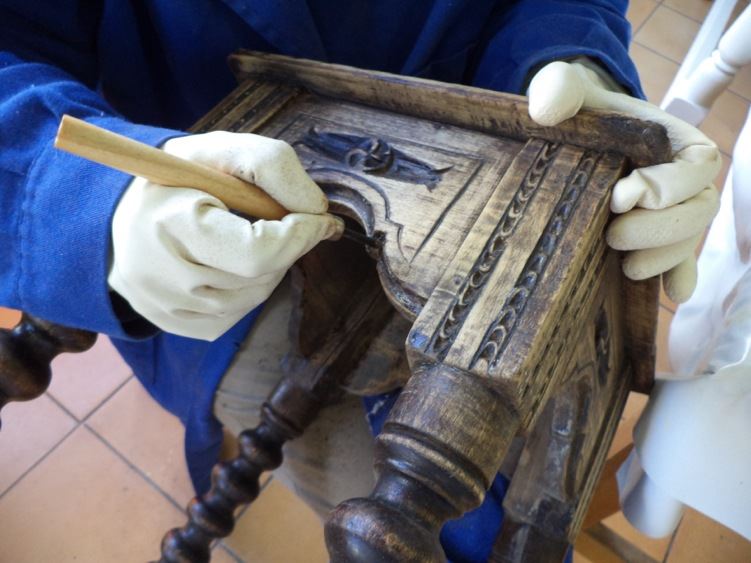
During our first winter in Ronda, I signed up for a furniture restauración course at the ancient Collegio de San Francisco. The course was scheduled to start on January 10th at 10 am, and foolishly keen and Norwegian that I am, I showed up early. I came to a closed door. Actually, that’s not true. I came to a cemented close door. The college is obviously not as busy as it was in the old days…
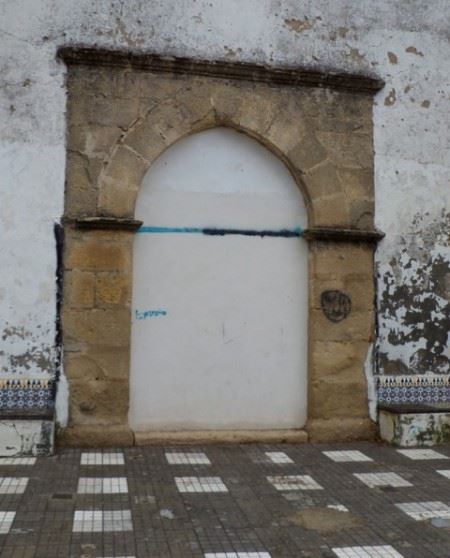 Still keen to start my new course, I checked a metal door to my left, also bolted closed. I knocked anyhow and then walked around the building. At a side-door, hidden by six months' worth of fallen leaves, there was a note saying that all classes had been moved to another collegio due to renovations and would start January 23. Thankfully, I had been in Spain long enough now to know that such notices may refer to years past, so I returned to the front of the building, waiting. And waiting. Still keen to start my new course, I checked a metal door to my left, also bolted closed. I knocked anyhow and then walked around the building. At a side-door, hidden by six months' worth of fallen leaves, there was a note saying that all classes had been moved to another collegio due to renovations and would start January 23. Thankfully, I had been in Spain long enough now to know that such notices may refer to years past, so I returned to the front of the building, waiting. And waiting.
Quarter after ten and there was still nobody there, so I hurried home to call the Casa de Cultura to inquire about the changed location or cancelled course. “No!”, they told me. “Por supuesto!” Of course the course is on! Just go back, and I would see them all there, the person said. And sure enough, just half an hour late, the first students started to trickle in, renovation projects in hand. The last student arrived half an hour before our class is over, keen as can be and of course without any excuse.
Our teacher, named and doubly blessed, Maria Jesus, was a spirited woman with a constant flow of words, wearing stylish brown riding boots and a white lab coat. (Turned out that we all need the latter) The class consisted of a dozen Spanish women between the ages of 50 and 80, some married, some widowed, all with time and money to spare and all loving things that were old, decrepit and with patina. I felt right in my element as they excitedly showed off their planned spring projects. Most had brought old tables, frames and trunks from their well-equipped homes, while others had found treasures on the street, literally while going dumpster diving! Unbelievably, these Spanish ladies with their perfect hair-does, their golden jewelry and neat little twin-sets under their checkered working-frocks told me which days to go to find the best treasures in the bins – on Wednesday nights before the city picks up the garbage on Thursday mornings. So here I was, a freshly accepted member of the Ladies of Ronda Dumpster Diving Society…
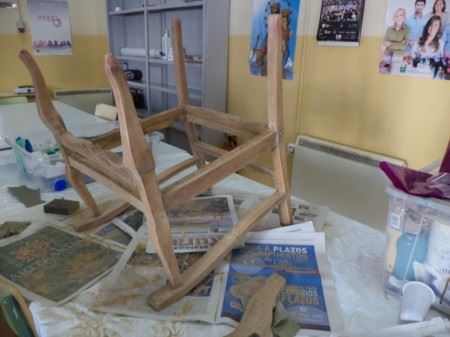 As a retiree exercise class sprung to life with Latin beats in the plaza outside the collegio, our group started the restoration work. Having moved here with 3 suitcases and not a stick of furniture, they let me inherit a lovely, curvatious, worm-infested skeleton of a chair, of which nobody could remember the rightful owner. Maria Jesus went through the list of items I needed for the course, including syringes to insert poison to kill the wood-bugs. Otherwise, I needed brushes and sandpaper and scrapers and all the stuff we had given away in Canada merely weeks before. "And bring some old T-shirts as rags", she told me. I had to admit that I didn’t even own an old T-shirt. Kind as they were, the group descended upon me with tools to borrow and extra stuff they let me use, so I could start stripping ‘my’ chair. As a retiree exercise class sprung to life with Latin beats in the plaza outside the collegio, our group started the restoration work. Having moved here with 3 suitcases and not a stick of furniture, they let me inherit a lovely, curvatious, worm-infested skeleton of a chair, of which nobody could remember the rightful owner. Maria Jesus went through the list of items I needed for the course, including syringes to insert poison to kill the wood-bugs. Otherwise, I needed brushes and sandpaper and scrapers and all the stuff we had given away in Canada merely weeks before. "And bring some old T-shirts as rags", she told me. I had to admit that I didn’t even own an old T-shirt. Kind as they were, the group descended upon me with tools to borrow and extra stuff they let me use, so I could start stripping ‘my’ chair.
And on the next Wednesday night, I was out there with the ladies of Ronda, plundering the city’s garbage bins for restorable treasures!
 1
Like
Published at 4:30 PM Comments (0)
1
Like
Published at 4:30 PM Comments (0)
Finally moving into our house in Ronda, at 43°C through a wobbly ladder
Friday, March 18, 2016
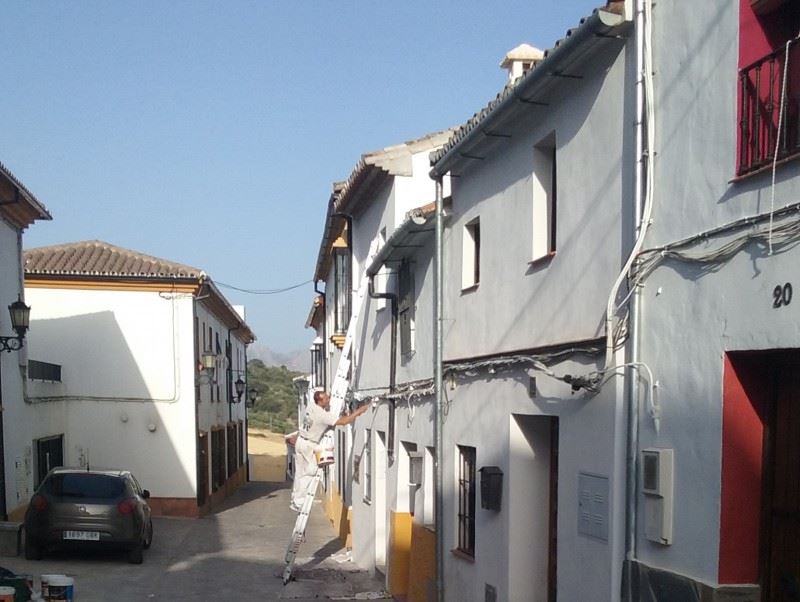
We had lost count on how long the construction process had lasted. The spring had flown away and we were still paying rent two years on. We decided to move in on July 01, as long as we had a roof, a loo and a front door. All we cared for was living in our own house. The rest was in the details and could be done until Kingdom Come.
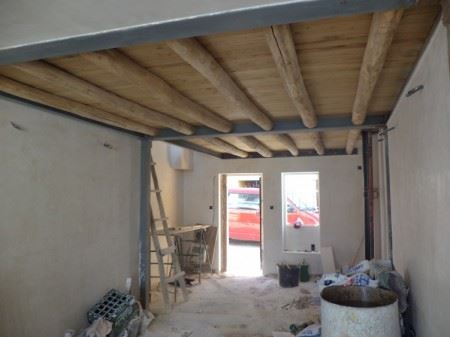 After far too many trans-Atlantic moves, this one seemed like a breeze. For one, we were only going a few blocks. Secondly, we had decided not to bring any of our book and art boxes, stored at a local convent, until we had shelves to put them onto. All we had to do was pack our clothes, toiletries and a few kitchen odds and ends. That’s all. Our earthly goods looked rather modest as they were spread about in our rental flat, but once we emptied closets and filled bag after bag, things started swelling out of hand. Without being aware of it, we had managed to acquire so much stuff that it would probably take a dozen carloads. Well, well, so much for my alleged zen-ness… After far too many trans-Atlantic moves, this one seemed like a breeze. For one, we were only going a few blocks. Secondly, we had decided not to bring any of our book and art boxes, stored at a local convent, until we had shelves to put them onto. All we had to do was pack our clothes, toiletries and a few kitchen odds and ends. That’s all. Our earthly goods looked rather modest as they were spread about in our rental flat, but once we emptied closets and filled bag after bag, things started swelling out of hand. Without being aware of it, we had managed to acquire so much stuff that it would probably take a dozen carloads. Well, well, so much for my alleged zen-ness…
Thankfully, we had a couple of days of grace period as our rental home was ours until July 3. We planned to move everything into our new house first and then return to clean up, leaving the flat spic and span for the owners. This was also a good thing because we still didn’t have a bed (details, details…). The frame and mattress, together with bathroom furniture and closets were to be delivered on July 01. Such tight timing can be very risky in Spain, but it was summer and we decided that we could always sleep on the terrace.
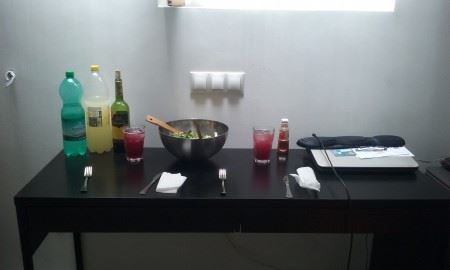
June 30th. The most yearned-after day finally arrived with not a cloud in the sky. Perfect moving weather, we thought. Sweat was already pouring down our faces as we brought the very first load to our vehicle. By 11 am, the temperature gage in our car showed 43 degrees and it was still creeping upwards, heading scarily close to the fifty degree mark. I was always told back in the old country (aka Norway) that southerners were lazy and hardly worked at all. Of course, compared to us Scandinavian workaholics with an innate protestant work ethic, congenital angst for sitting still, and seeing idleness as the root to all evil, most Spaniards will seem a little happy-go-lucky. But living in southern Spain, I have come to realize that blasting sun and plus-forty temperatures are not conducive to fast-paced physical work. A little to late, it occurred to us that moving is probably not advisable at the height of the Andalucían summer. However, sunstroke or not, we were hell-bent on getting there. With numerous water breaks we got done before nightfall, ending the day with a most deserved cerveza at the local bodega.
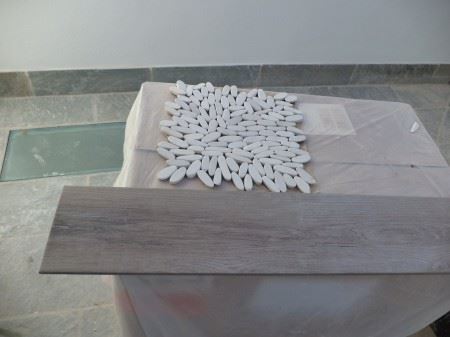
July 1st. After crashing back at the ‘old’ flat, we were up at the crack of dawn heading for our new house. If all went to plan, this would be our first night in our very own Ronda home. Of course we had no kitchen and the stairs to the second floor was still at the drawing stage, so everything had to be moved upstairs through a wobbly old stepladder that we found in the basement of the house. (We had somehow forgotten to tell this fact to the IKEA delivery company…) We had actually already given away the ladder to our neighbour for their olive trees, but the construction team kept needing it, so we kept delaying bringing it to them, which turned out rather timely, since this was now our only means of getting upstairs.
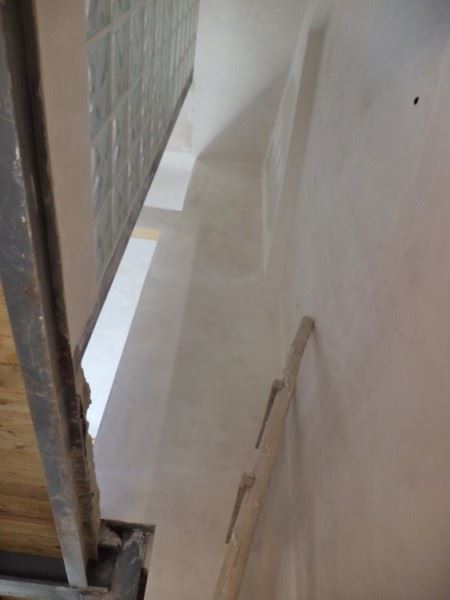
The house was a jumble of activities, as an installer was fitting the German windows and sliding doors at the back of the house and the kitchen counter was to be measured, though the kitchen was not yet built. (My husband and I had rather bravely decided that we would put together the kitchen ourselves, and somehow survive without either killing the other…) The construction team had cleared out, but the painters were still working on the outside of the house. The more the merrier, they say…
We expected the IKEA delivery guys at the earliest in the later afternoon (nothing ever happens on schedule here), but lord and behold, we got a call about 11 am telling us that they were at the top of our street with their giant truck. We hoped that they would oversee the small fact of the missing stairs. Of course they didn’t, but after a small pow wow outside they came and told us that they would do the job all the same.
The delivery and installation trio turned out to be the perfect team. The most senior, and by far the heaviest, huffed up the ladder and barely managed to squeeze though the opening, starting installing our bathroom cabinets with fierce speed and efficiency. Meanwhile, a long skinny lad remained downstairs, handing box after box hand over fist to the youngest and most acrobatically inclined lad straddled between the wall and the last rung of the ladder on the second floor. Once they had gotten all the boxes upstairs, it was discovered that our mattress would not fit through the opening and had to be roped from the lower to the upper terrace. No problem. The lads were onto it. I went at steady intervals to buy them cooling drinks to make amends and to stave off the overwhelming heat. Particularly our heavier fellow was drenched when the work was done and heaven knows how, but he did manage to get down the ladder in on piece. We could not thank them enough before they drove off, no extra charge.
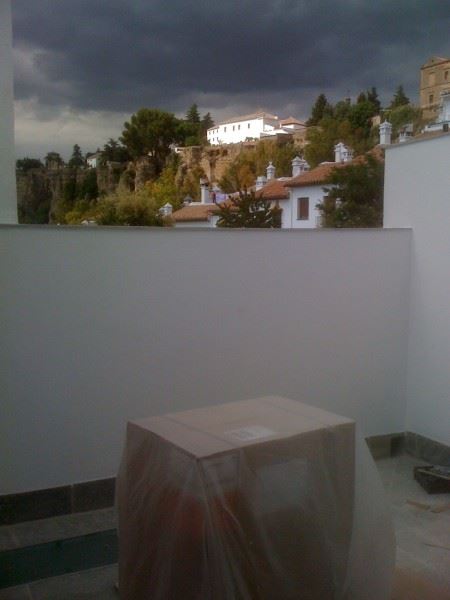 The evening came sure enough, though not the long awaited cooling of the air. Alberto the painter and his team had finished the exterior walls and packed up. The window fitter had long left and all the empty IKEA boxes had been dragged up to the recycling bin on the corner. We were exhausted and only wanted to fall into the newly installed bed. We had managed to dig out a sheet from the bags. In this heat thankfully all one needs is a single sheet as cover, or not even that. Lying in our very own bed, looking out at the starry sky and the silhouette of Ronda’s historic quarter with ancient church towers that once were minarets, we could hardly believe we were here. Home at last! The evening came sure enough, though not the long awaited cooling of the air. Alberto the painter and his team had finished the exterior walls and packed up. The window fitter had long left and all the empty IKEA boxes had been dragged up to the recycling bin on the corner. We were exhausted and only wanted to fall into the newly installed bed. We had managed to dig out a sheet from the bags. In this heat thankfully all one needs is a single sheet as cover, or not even that. Lying in our very own bed, looking out at the starry sky and the silhouette of Ronda’s historic quarter with ancient church towers that once were minarets, we could hardly believe we were here. Home at last!
We knew fully well that had this been Canada or Norway or in almost any other country, the furniture installers would have refused blankly to proceed, insisting that moving into a house without a proper set of stairs was against their union rules, too unsafe, too wobbly or simply not in their work description. But this is Spain and things work differently here. And sometimes that is a blessing!
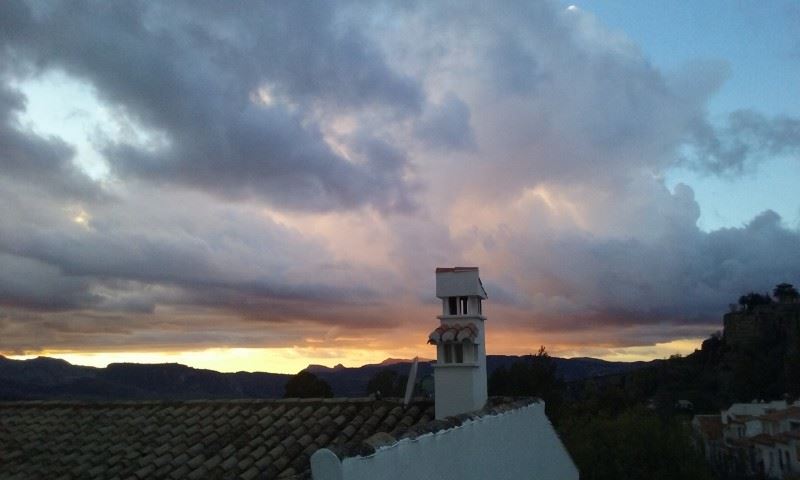
 5
Like
Published at 4:37 PM Comments (2)
5
Like
Published at 4:37 PM Comments (2)
Forget about tax-free and Bobbies. Hiking La Roca
Friday, March 11, 2016
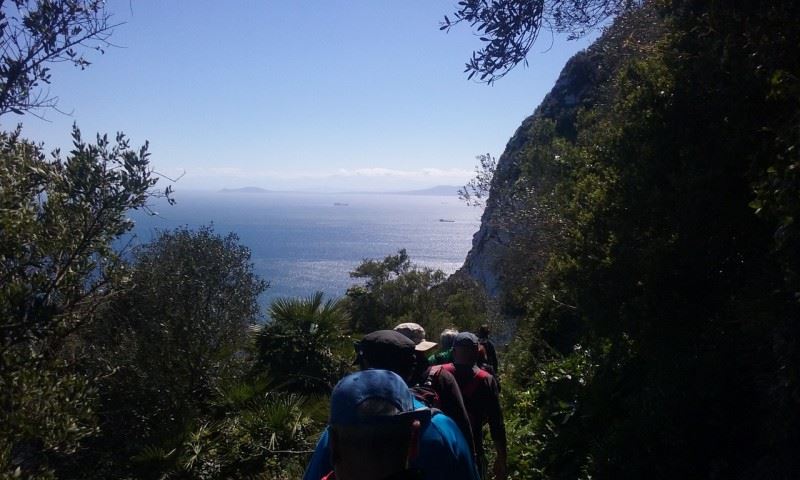 I never thought I would say this, but I love Gibraltar! Not the tax-free shopping, mind you, nor the pubs, the casinos, nor the pesky monkeys. La Roca as the Spanish call sometimes it has a side that most visitors never see – kilometers of jungle-like trails with spectacular ocean views. I never thought I would say this, but I love Gibraltar! Not the tax-free shopping, mind you, nor the pubs, the casinos, nor the pesky monkeys. La Roca as the Spanish call sometimes it has a side that most visitors never see – kilometers of jungle-like trails with spectacular ocean views.
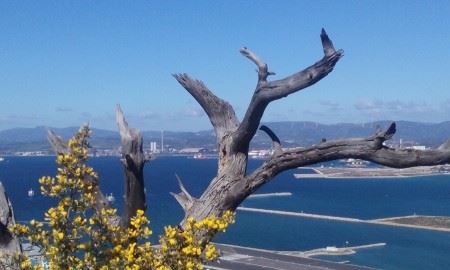 Gibraltar is a small rocky outcrop (less than 7 km2) that has belonged to the British since 1704, in spite of numerous unsuccessful attempts by the Spanish to change this fact. Today some 30.000 Gibraltarians populate the rock, practically living within sight of Africa. In the latest referendum in 2002, over 98% of the voting population wanted to remain British – and proudly so. The rock is beset with military monuments, as well as over 50 km of tunnels. However, most of the 12 million annual visitors (one of the highest visitor to local population ratio in the world) come there for the tax-free shopping, Marks and Spencer’s, the British Bobbies, English pubs or gambling in one of its 25+ casinos. Some visitors will venture with a taxi or a cable car to the top of the rock for the typical ‘monkey with African coast’ photo, but few will venture further. Yet, Gibraltar’s true beauty is its natural setting, the flora, fauna and its geological riches. Perched above the busy town centre, 420 m above the sea level, is one of Europe’s greatest natural reserves. Gibraltar is a small rocky outcrop (less than 7 km2) that has belonged to the British since 1704, in spite of numerous unsuccessful attempts by the Spanish to change this fact. Today some 30.000 Gibraltarians populate the rock, practically living within sight of Africa. In the latest referendum in 2002, over 98% of the voting population wanted to remain British – and proudly so. The rock is beset with military monuments, as well as over 50 km of tunnels. However, most of the 12 million annual visitors (one of the highest visitor to local population ratio in the world) come there for the tax-free shopping, Marks and Spencer’s, the British Bobbies, English pubs or gambling in one of its 25+ casinos. Some visitors will venture with a taxi or a cable car to the top of the rock for the typical ‘monkey with African coast’ photo, but few will venture further. Yet, Gibraltar’s true beauty is its natural setting, the flora, fauna and its geological riches. Perched above the busy town centre, 420 m above the sea level, is one of Europe’s greatest natural reserves.
We jumped on the chance to go to see this when RF Natura, a Ronda-based nature-excursion company, arranged a 14 km day-hike across the rock. It is not my intension to endorse companies, but when it comes to hiking in the mountain ranges and natural parks around here, one is best advised to go with an experienced guide, unless one wishes to become a vulture’s lunch. RF Natura’s founder, Rafael Flores, is an author and editor of several books about Andalucian nature. He knows every peak and valley from Southern Spain to the Atlas Mountains and will excitedly exclaim the Latin name of every rare flower as we trek along. With his trusted team of experienced co-guides, we could not imagine anybody better to lead our day-hike across the rock.
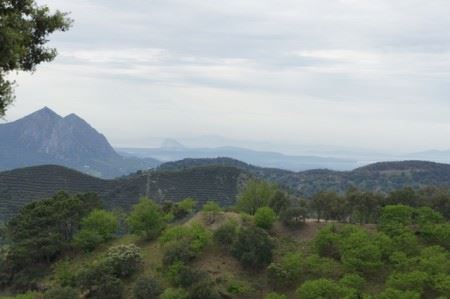 Whether one drives the costal road from San Pedro, or overland from Ronda to Algeciras, at one point one will see this emblematic and stately rock, marking the end of Europe. El Peñon de Gibraltar is quite unique from a geological point of view, as it is the only monolithic limestone rock in the area. The surrounding costal mountains are primarily sandstone based. The formation of the limestone that today is known as Gibraltar began during the Jurassic Period with the accumulation of shells and marine organisms. As Gibraltar is located near the boundary between the Eurasian and African plates, the compression lifted the limestone layer above sea level. Today, curiously, only the isolated rock remains. Whether one drives the costal road from San Pedro, or overland from Ronda to Algeciras, at one point one will see this emblematic and stately rock, marking the end of Europe. El Peñon de Gibraltar is quite unique from a geological point of view, as it is the only monolithic limestone rock in the area. The surrounding costal mountains are primarily sandstone based. The formation of the limestone that today is known as Gibraltar began during the Jurassic Period with the accumulation of shells and marine organisms. As Gibraltar is located near the boundary between the Eurasian and African plates, the compression lifted the limestone layer above sea level. Today, curiously, only the isolated rock remains.
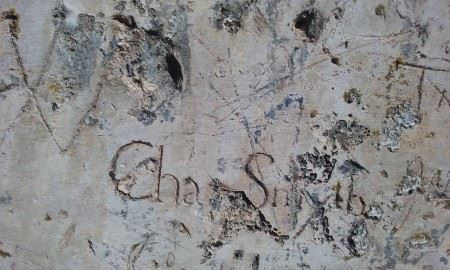 To avoid border delays, we left the bus in the Spanish border town of La Linea, walking across the border checkpoint and the somewhat treacherous-looking runway of Gibraltar’s airport. Passing through Main street, with all stores closed and hardly a soul in site, we took off up a side street, which soon narrowed into one of the several flights of steps taking one up to the middle green belt, crossed by corkscrew roads, meandering their way up to Gibraltar’s upper rock. It was quite amazing to walk through a lush jungle-like forest on a peninsula that has no natural water reserves, rivers nor streams. Gibraltar’s water used to be provided by aqueducts, wells and captured rainwater, though today its supply of drinking water comes entirely from desalination from huge underground, or should I say under-rock reservoirs. Also scattered along the hike, was numerous bunkers, military barracks and other monuments, as testaments to the rock’s feisty past. I am not one to ohh and ahh at a canon, but I did like the 250-year-old graffiti carved by soldiers, some with the nicest penmanship, into the crumbling limestone walls. To avoid border delays, we left the bus in the Spanish border town of La Linea, walking across the border checkpoint and the somewhat treacherous-looking runway of Gibraltar’s airport. Passing through Main street, with all stores closed and hardly a soul in site, we took off up a side street, which soon narrowed into one of the several flights of steps taking one up to the middle green belt, crossed by corkscrew roads, meandering their way up to Gibraltar’s upper rock. It was quite amazing to walk through a lush jungle-like forest on a peninsula that has no natural water reserves, rivers nor streams. Gibraltar’s water used to be provided by aqueducts, wells and captured rainwater, though today its supply of drinking water comes entirely from desalination from huge underground, or should I say under-rock reservoirs. Also scattered along the hike, was numerous bunkers, military barracks and other monuments, as testaments to the rock’s feisty past. I am not one to ohh and ahh at a canon, but I did like the 250-year-old graffiti carved by soldiers, some with the nicest penmanship, into the crumbling limestone walls.
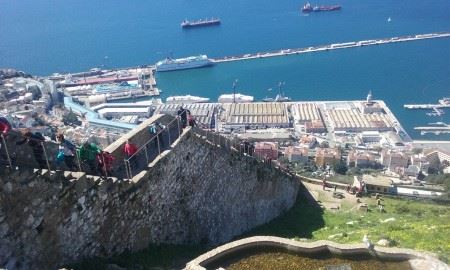 The final ascent was a steep climb up the Queens Gate steps, several flights of stone stairs, part of it originally built as a wall by Philip II of Spain in the 16th century. This is a great place to take a breather (or assure that a heart attack is not coming on, for those who rarely walk) and to enjoy a bird’s eye view of Gibraltar and further away in the sea mist, the busy harbour of Algeciras. Coming to the top at last, we stepped straight onto the road that bridge the two semi peaks of the Upper Rock Nature Reserve area. At some part of the day, this would be bumper to bumper minivan taxis, though when we got there, there were thankfully none. There was only a contingency of the islands most famous residents meeting us. Gibraltar’s Barbary macaques are allegedly the only wild population of monkeys in Europe. I say allegedly, as the monkeys sit plumped down like sloths on the roadway, barely moving out of the way for traffic, while waiting for a ‘benevolent’ tourist to throw them a scrap of food. Feeding the monkeys is highly illegal, as they now have their own feeding grounds. Watching the monkeys felt rather sad to me, and I could certainly understand that some of them have attacked the occasional tourist, as these flail away with their selfie sticks. I would too, if I was stranded up there with only delousing my fellow monkey mates as my past time. The final ascent was a steep climb up the Queens Gate steps, several flights of stone stairs, part of it originally built as a wall by Philip II of Spain in the 16th century. This is a great place to take a breather (or assure that a heart attack is not coming on, for those who rarely walk) and to enjoy a bird’s eye view of Gibraltar and further away in the sea mist, the busy harbour of Algeciras. Coming to the top at last, we stepped straight onto the road that bridge the two semi peaks of the Upper Rock Nature Reserve area. At some part of the day, this would be bumper to bumper minivan taxis, though when we got there, there were thankfully none. There was only a contingency of the islands most famous residents meeting us. Gibraltar’s Barbary macaques are allegedly the only wild population of monkeys in Europe. I say allegedly, as the monkeys sit plumped down like sloths on the roadway, barely moving out of the way for traffic, while waiting for a ‘benevolent’ tourist to throw them a scrap of food. Feeding the monkeys is highly illegal, as they now have their own feeding grounds. Watching the monkeys felt rather sad to me, and I could certainly understand that some of them have attacked the occasional tourist, as these flail away with their selfie sticks. I would too, if I was stranded up there with only delousing my fellow monkey mates as my past time.
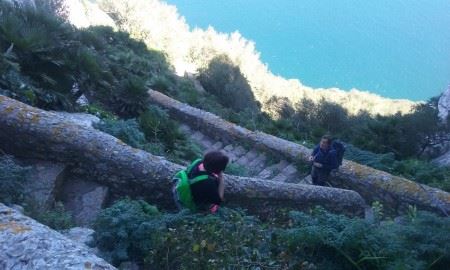 The top of the reserve still has some closed off military installations, though there are several stunning nature paths, some open to the public. Our guide Antonio led us to the beginning of the famous Mediterranean Steps, located entirely within the Nature Reserve. Originally built by the British military, is its now a pedestrian route from Gibraltar’s summit, descending through steps partly cut into the ground rock along the steep southern side of the rock, offering views of the Mediterranean and the coast of Africa. The top of the reserve still has some closed off military installations, though there are several stunning nature paths, some open to the public. Our guide Antonio led us to the beginning of the famous Mediterranean Steps, located entirely within the Nature Reserve. Originally built by the British military, is its now a pedestrian route from Gibraltar’s summit, descending through steps partly cut into the ground rock along the steep southern side of the rock, offering views of the Mediterranean and the coast of Africa.
There are times when a picture can say a thousand words, and this is certainly one of those occasions. The blue cloudless sky, the silvery sea, the white limestone rock, the deep green tropical foliage with shocking yellow blooms throughout. I was completely in awe, drinking in the colours, hand over footing down the stairs, while clicking pictures like a Japanese tourist. I know it sounds banal, but I simply had to bring this feast for the eyes with me.
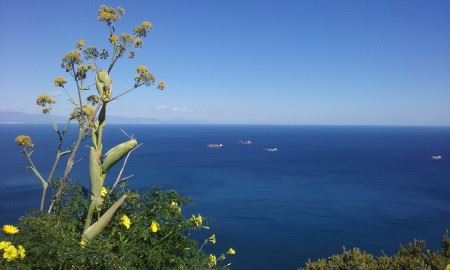 Gibraltar has more than 600 plant species, three of which are endemic and found nowhere else. In addition, there are species native to North Africa and Gibraltar is the only place in Europe where they are found. There are also wild white freesia, sweet-scented wild honeysuckle and sea lavender to name a few. The nature reserve is also home to about 300 species of birds, some permanently residing here, while others appear during their bi-annual migrating season. The rock of Gibraltar serves as a temporary stopover for many migrating species before continuing over waters or deserts en route to far-away places such as Russia or Greenland. Gibraltar has more than 600 plant species, three of which are endemic and found nowhere else. In addition, there are species native to North Africa and Gibraltar is the only place in Europe where they are found. There are also wild white freesia, sweet-scented wild honeysuckle and sea lavender to name a few. The nature reserve is also home to about 300 species of birds, some permanently residing here, while others appear during their bi-annual migrating season. The rock of Gibraltar serves as a temporary stopover for many migrating species before continuing over waters or deserts en route to far-away places such as Russia or Greenland.
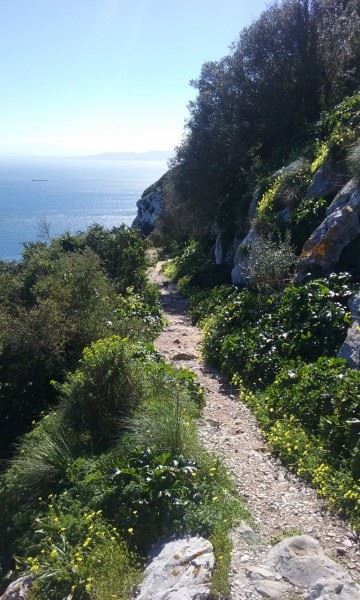 Being of limestone, it is not surprising that Gibraltar also contains caves. The most famous, St. Michael’s Cave, has amazing stalactites and stalagmites, though the large concert venue and multi-coloured lighting gives it a somewhat theme park feel. However, Gorham’s Cave, located on the steep eastern face of the rock, is a hidden treasure. Archaeological excavations have found evidence that Neanderthals used it some 25,000 – 30,000 years ago, suggesting that this may be the place that our stoop-backed, heavy-fronted ancestors died out. Being of limestone, it is not surprising that Gibraltar also contains caves. The most famous, St. Michael’s Cave, has amazing stalactites and stalagmites, though the large concert venue and multi-coloured lighting gives it a somewhat theme park feel. However, Gorham’s Cave, located on the steep eastern face of the rock, is a hidden treasure. Archaeological excavations have found evidence that Neanderthals used it some 25,000 – 30,000 years ago, suggesting that this may be the place that our stoop-backed, heavy-fronted ancestors died out.
The peninsula’s history and legends didn’t end there. The final stretch of our hike as we entered paved ground showed the place where one of the Pillars of Hercules once stood, guarding where the Mediterranean and the Atlantic Ocean meet. Clearly after such astonishing views, Gibraltar’s Main Street and a rather lame and costly coffee (in Gibraltar Pounds, of course) came as a bit of an anti-climax. Yet, having done only a partial hike, our guide Antonio promised to bring us back another day to do the entire 31 km of paths on Gibraltar’s Upper Rock Nature Reserve. Any takers?
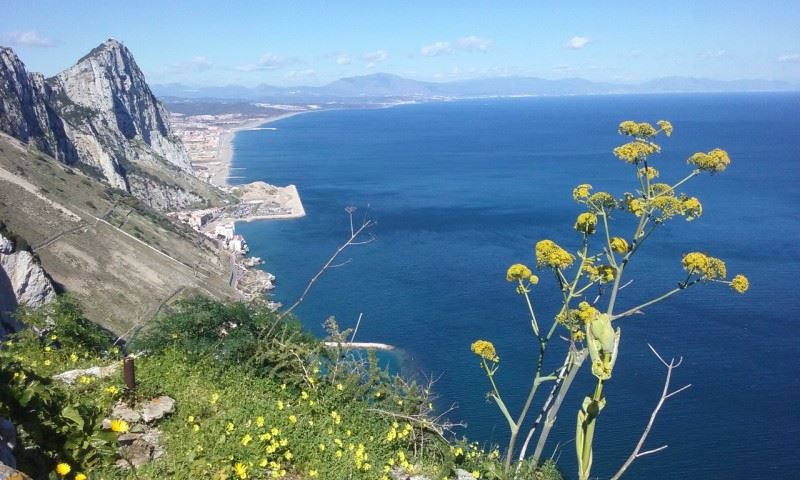
 0
Like
Published at 9:22 PM Comments (1)
0
Like
Published at 9:22 PM Comments (1)
The Rain in Spain...
Friday, March 4, 2016
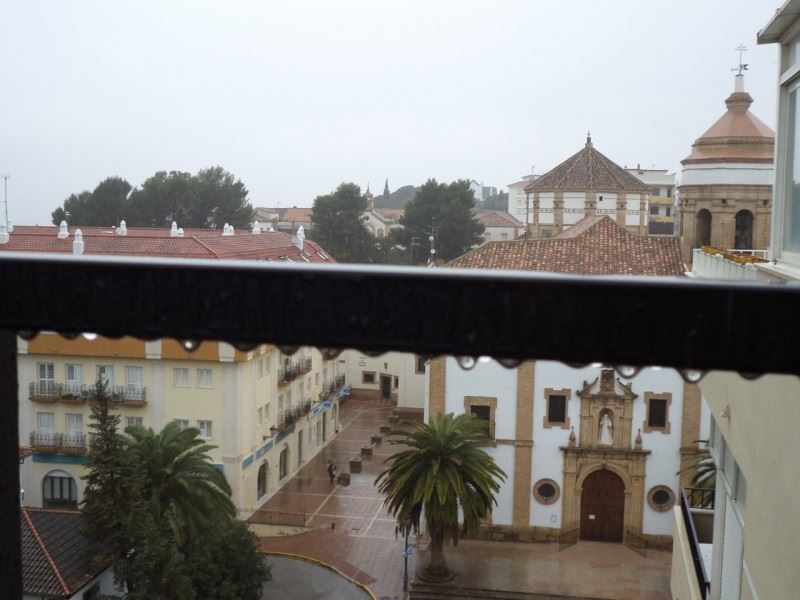
Unless one is Professor Higgins, most people know Spain as a sunny place. In fact, millions upon millions of people from all over the world (my own clan, the Vikings probably ranking highest on the list) travel to Spain every year exactly for that purpose, to bask and fry in the Spanish rays. Granted, that was the old planet, and not the seasonally dyslexic planet we now have created. However, it is true - Spain is a sunny place for the vast majority of visitors, for most locations and most days of the year.
Andalucia being the southernmost and sunniest part of Spain, was an important reason we chose this as our new home. In addition to the close proximity to family, the healthy Mediterranean lifestyle, reasonable prices, great wine and local grown everything and a few hundred other reasons, the weather certainly was a major deciding factor.
As we left Vancouver, we had had more or less one month of steady downpour, so we were definitively ready for some drier days. We took off in rain, flying east skirting the remnants of a hurricane named Sandy, touching down in Zurich, (that is Switzerland, for those who like me have black holes in their geography) then on to the Iberian continent. Landing in Malaga, the runway witnessed recent rain. We picked up our rental car and headed straight for the cloud-covered mountains. The motorway became a two-lane highway and then shrunk into a single-lane country road as we approached the mountain chains surrounding Ronda. A Sleepy Hollow like fog envelops us, making the Andalucian landscape of scattered olive trees and ruined stone barns even more painterly and romantico.
By the time we reached Ronda and found our rental home for the week it was pitch black and raining sideways. Our landlord asked us to keep the exterior blinds (generally use for sun-cover) down, as it helped keep the rain out from entering the double-glazed windows plus wooden shutters. Houses here are not constructed for rain, he told us.
The Ronda weather is not like Vancouver's consistent weeping skis. In the space of minutes, walking across Puente Nuevo (as in 1793) that gaps the old and the newer town, we had gusts of wind that could flatten a grown man, followed by a lightening-brief moment of clear sky, then seconds later another sideways downpour, which lasted only a minute, mind you, then stopped, overtaken by wind, a flash of sun, then a gust of sideways rain again. Like the people themselves, the Spanish rain seems to have an unpredictable Latin temper.
We stopped for lunch (a 2 course menu del dia, including beer and desert for seven euro) to escape the rain, and chatted with Antonio, who seemed to run the joint since he got the optimal viewing spot for the TV soccer game when there were no guests around. Like others, he spoke of how the weather has changed, how months that used to be sunny, now may be rainy and visa versa. Nobody knows what to expect anymore, he said, telling us how the old people around here used to know how to predict the weather. Now, they have to be ready for everything.
As I accustom my tongue and try to learn a new language, I feel like Eliza Doolittle being taught how to say “The rain in Spain falls mainly on the plain”. Oh and did I mention that the airline lost our bag with the umbrella...
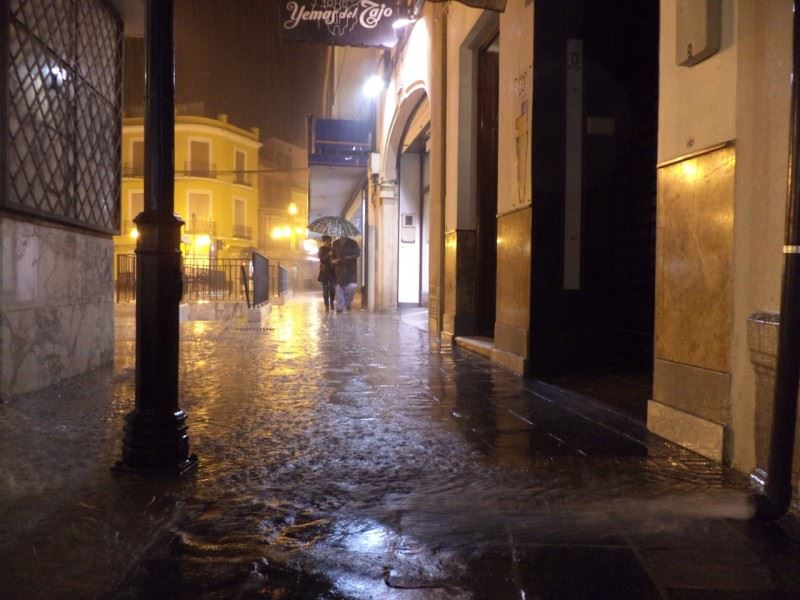
 0
Like
Published at 3:31 PM Comments (1)
0
Like
Published at 3:31 PM Comments (1)
Spam post or Abuse? Please let us know
|
|